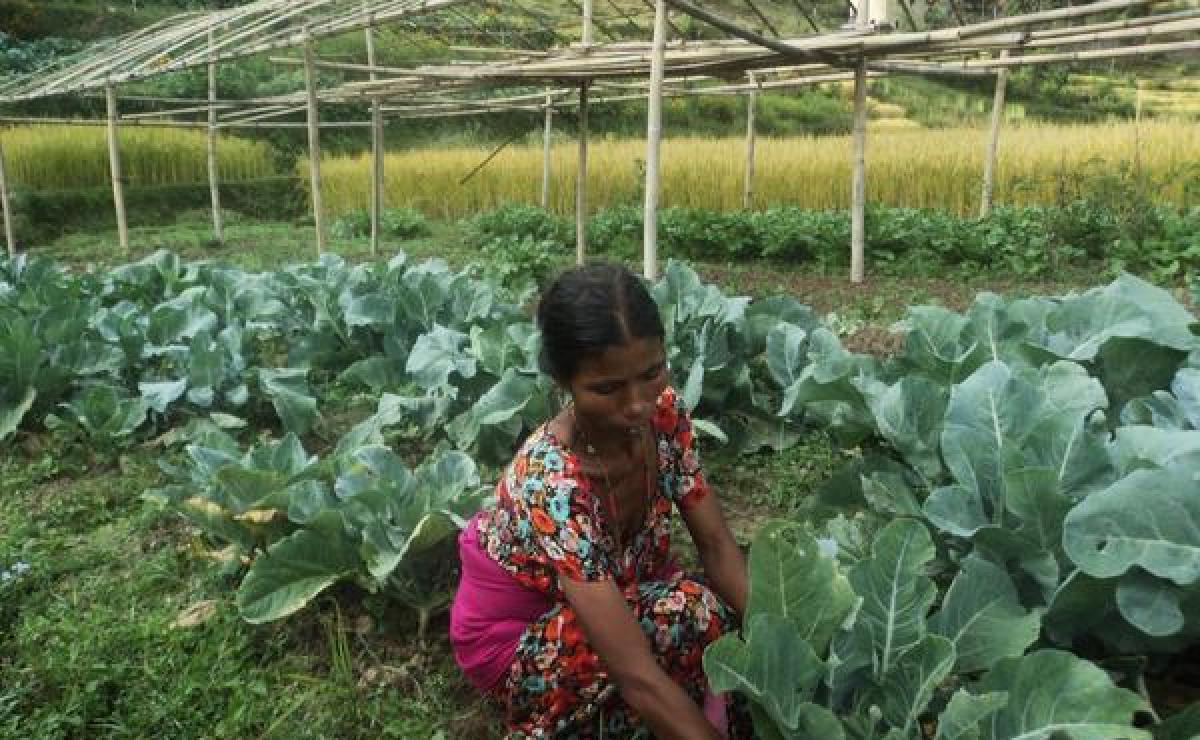“Live with more dignity and respect”

KATHMANDU, Nepal/ GENEVA, 20 October 2015 (LWI) - When a magnitude 7.8 earthquake struck Nepal half a year ago, it seemed to Saraswati Purkoti that life had ended. The single mother of three lost her home and chance of earning some income as a daily laborer. But life took an unexpected turn. Today, with the support of The Lutheran World Federation (LWF) Nepal and its partners, Purkoti has a steady income from vegetable farming. She and her children no longer go to bed hungry.
“I was cutting grass on the hill with my son when the earth started trembling. We hugged each other, crying. After some time we ran down to the village, only to find that the house had gone. I felt my life had ended,” recounts 40-year old Purkoti . Her life has never been easy, and got even harder when her husband disappeared during Nepal’s civil war in the 1990s. “Being illiterate I had no other choice but to work as a daily laborer to feed my children. I no longer felt like eating and lost so much weight,” she says.
A new livelihood
With less work available after the earthquake, Purkoti no longer knew how to survive after the distributions of relief goods finished. She had received materials to build a temporary shelter and toilet, but still felt there was no future for her and the children.
That was when LWF Nepal stepped and encouraged her to rent a piece of land for vegetable farming. The woman, looking weak after months of hunger, received seeds, tools and materials to build a simple greenhouse. In two months, she earned 8,000 Nepali Rupies (428 USD) from selling vegetables. Most people in Nepal live on 14 USD a month.
When visiting Chhampi, a village in the deep south of the Kathmandu Valley, one notices some major changes after the earthquake. As many houses sustained major damages, their occupants still live in temporary shelters, made from corrugated iron sheets. One of the schools has been transformed into a shelter area, where people live in class rooms, and keep their animals in makeshift huts. But the most surprising change can be seen in the rolling fields below the village: in between large patches of rice one finds vegetable gardens, under greenhouses made from bamboo, covered with plastic sheets. The pumpkins, cucumbers, tomatoes, spinach and cauliflowers create colorful patches in the landscape.
Living on the edge
People like Purkoti are among the poorest of the poor, and were already living on the edge before the earthquake. They belong to Dalit or artisan communities, who despite the eradication of the caste system, tend to face discrimination in all spheres of life. Although Lalitpur district is situated inside the Kathmandu Valley, some 35,000 people – ten percent of the population - here live below poverty level. , One third of the population have no access to safe drinking water, 16 percent of the children are malnourished. Only one in five adults can read and write. Some villages are located over 70 km from the city, and some of them are completely inaccessible during monsoon.
During the earthquake, 177 people in Lalitpur district lost their lives, 24% of the houses were destroyed, and 149 of 200 government schools collapsed.
LWF Nepal, with its implementing partner Integrated Community Development Organisation (ICDO) has been operating an integrated development program in five Village Development Committees (VDC) of the district since 2010.
After the earthquake, with support of Amity Foundation and the ACT Alliance, an emergency response was put in place in eleven villages, and the livelihood support was extended to those villages which had been destroyed by the earthquake. More than 2,300 families were supported with temporary shelters and toilets, solar lights, blankets and water tanks, and 5,500 people received psycho-social support.
Prevent poverty and starvation
In Chhampi VDC alone 810 families lost their property during the earthquake. The most vulnerable like Purkoti, received livelihood support. Social mobiliser Durga Purkoti says the help has been a lifesaver for these families: “The families are now able to feed their children and work whenever they have time. They have nutritious food to eat, and their life in general is not as hard as it used to be before. But what is most important: they have new hope,” Purkoti says.
Six months after the earthquake, LWF has moved from providing emergency relief to recovery support. The organization and its partners will be providing support in building permanent shelters for the most vulnerable, including the very poor, single-headed households, the elderly and people living with disabilities. The families will also receive livelihood support, in the form of seeds, tools or training. Broken water systems will be repaired, hygiene improved and psychosocial support continued.
The interventions consist of relatively small amounts and may not seem much to some. But they have the potential to prevent starvation and abject poverty among earthquake survivors, says Emergency Response Manager Sufi Mohammed Faiz. “Some cry when we hand over materials. They tell us it’s the first time anyone ever reached out to them. ‘Now we can live with more dignity and respect’, they say.”
It takes only one look at Purkoti to know that to be true.

